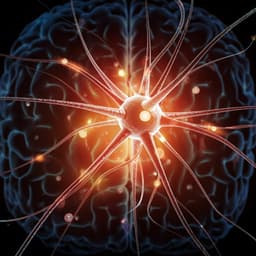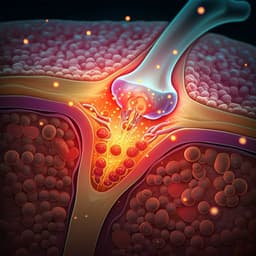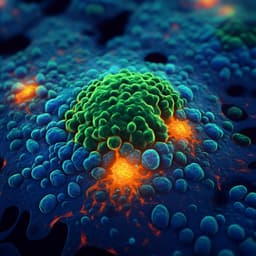
Medicine and Health
Characterization of a pluripotent stem cell-derived matrix with powerful osteoregenerative capabilities
E. P. Mcneill, S. Zeitouni, et al.
Discover groundbreaking research by Eoin P. McNeill and colleagues on a revolutionary stem cell line derived from induced pluripotent stem cells that could transform bone fracture treatments. This new osteogenic cell-matrix outshines traditional healing methods, potentially providing a better alternative to autografts and BMP products in bone tissue engineering.
~3 min • Beginner • English
Introduction
The study addresses the need for a safe, reproducible, and manufacturable bone-regenerative material that mimics anabolic bone. Conventional options (autograft, BMP2, synthetic and cadaveric products) have limitations including donor site morbidity, variable efficacy, adverse effects, and batch variability. MSCs promote osteogenesis and immunomodulation but suffer donor variability and supply limitations. Induced pluripotent stem cell-derived MSCs (ihMSCs) offer a reproducible, theoretically unlimited source. Prior work showed that osteogenically enhanced hMSCs (OEhMSCs) secrete an extracellular matrix (hOCM) enriched in collagen VI and XII that enhances osteogenesis. The current study hypothesizes that ihMSCs can generate abundant, highly osteogenic ECM (ihOCM) that surpasses BMP2 in vivo and functions via mechanisms involving the cWnt/PPARγ axis and collagen VI/XII-mediated signaling.
Literature Review
Background highlights include: (1) High burden of delayed/nonunion fractures and costs. (2) Limitations of current therapies: BMP2 can cause inflammation and ectopic ossification; autograft limited by morbidity and availability; synthetic and cadaveric products can be poorly biocompatible with batch variation. (3) MSCs are safe but variable; iPSCs provide a consistent source. (4) Previous studies from the group demonstrated that OEhMSCs produce hOCM rich in anabolic bone collagens (types VI and XII) that enhance osteogenesis and angiogenesis and improve bone healing when co-delivered with cells. (5) Broader context on bone repair products (DBM, synthetics, biologics, cellular allografts) and their drawbacks; radiomorphometric predictors (BMD, surface:volume) as surrogates for biomechanical properties in small animal calvarial models.
Methodology
- Cell sources and culture: ihMSCs were generated from a defined iPSC line by culture on Matrigel with TGFβ inhibition. Bone marrow-derived hMSCs (two donors) were obtained from a distribution facility. Cells were cultured in alpha-MEM with 20% FBS, glutamine, and antibiotics. Expansion at low density; passages 2–4 used.
- Characterization of ihMSCs: Morphology, proliferation (doubling time, cumulative yield), colony-forming efficiency, immunophenotyping (CD73, CD90, CD105 positive; hematopoietic and HLA-DR negative), immunomodulation (CFSE lymphocyte proliferation inhibition; reduction of TNFα in LPS-stimulated macrophages). Trilineage differentiation assessed: osteogenesis (OBM: 5 mM β-glycerophosphate, 50 μg/mL ascorbic acid with or without dexamethasone), chondrogenesis (pellet culture, toluidine blue), adipogenesis (standard cocktail; modulated by troglitazone or β-catenin inhibitor CCT032374). Mineralization quantified by Alizarin Red S (ARS) extraction. qRT-PCR for lineage markers.
- Signaling studies: Tested cWnt/PPARγ axis under osteogenic stimulus using subcellular fractionation and immunoblotting for GSK3β, β-catenin, PPARγ isoforms. Pharmacological PPARγ inhibition with GW9662 (up to 10 μM) under osteogenic conditions to generate OEihMSCs; ALP activity assays and mineralization monitoring.
- ECM production (ihOCM and hOCM): OEihMSC and OEhMSC monolayers cultured 10 days in OBM ± 10 μM GW9662. ECM was harvested via freeze-thaw, detergent and nuclease digestion, mild trypsinization, extensive washing (including chloroform and acetone), and stored dry at −80°C. ECM yields quantified by mass, protein (BCA), calcium (Arsenazo III), and GAG (Blyscan).
- Proteomics and matrix characterization: LC-MS/MS of ECM preparations (with and without GW9662) to identify protein composition; hierarchical clustering of proteomic signatures. SEM and EDS to visualize and confirm calcified nodules. Immunoblotting and densitometry for collagen VI and XII. Additional proteomics on gel-fractionated ECM to detect periostin and TGFβ-induced protein ig-h3.
- Functional assays on matrix: hMSCs/ihMSCs attached to ihOCM generated ± GW9662; measured ALP activity and OPG secretion during early osteogenic differentiation.
- Gene knockdown: Lentiviral shRNA to generate stable knockdown lines targeting collagen VIα3 (KD6) or collagen XIIα1 (KD12) in OEhMSC1; scrambled shRNA as control. Validated by immunoblot and qRT-PCR. Assessed proliferation (growth curves), colony formation and size, apoptosis, immunophenotype, adipogenesis/chondrogenesis, mineralization (ARS), ALP, and OPG. Immunocytochemistry for collagen VI/XII localization at intercellular contacts.
- In vivo calvarial defect model: Immune-compromised NU/NU mice received unilateral 4 mm full-thickness parietal defects (critical-sized). Treatments included: negative control (no graft), gelatin foam (GF) ± BMP2 (0.1 mg/mL), OEihMSCs + GF, hBM + GF; ihOCM alone; ihOCM + OEihMSCs; ihOCM + hBM. Cells delivered in clotted human plasma. Healing evaluated at 4 weeks by μCT. A healing index (HI) defined where 1 equals volume equal to the contralateral side; 0 equals no healing. Thresholding excluded radiolucent ihOCM. Radiomorphometrics: bone surface:volume ratio and BMD (calibrated with HA phantoms); comparison with host calvarial, femoral, vertebral, and iliac bones. Histology: H&E and Masson’s trichrome; TRAP staining to assess osteoclast activity.
- Statistics: t-tests and one-way ANOVA with Dunnett’s or Tukey’s post-tests; sample sizes per figure specified; significance threshold p < 0.05.
Key Findings
- ihMSC characterization: ihMSCs exhibited spindle morphology, robust proliferation (average doubling time ~20 h), stable growth to passage 4 before senescence; immunophenotype typical of MSCs (CD73 98%, CD90 99%, CD105 99%, HLA-DR 0%; CD14 41%, CD19 0%, CD34 1%, CD45 0% as shown in figure panel). ihMSCs suppressed lymphocyte proliferation and reduced TNFα from LPS-stimulated macrophages.
- Osteogenic propensity: ihMSCs mineralized strongly and outperformed two BM-hMSC donors (order: ihMSC > BM-hMSC1 > BM-hMSC2). Notably, ihMSCs mineralized in OBM without dexamethasone, unlike BM-hMSCs.
- Signaling: Osteogenic stimulus reduced cytosolic GSK3β and increased nuclear/insoluble β-catenin; PPARγ isoforms were downregulated in the insoluble fraction. GW9662 further increased β-catenin and decreased GSK3β, elevating ALP and mineralization.
- ECM yields/composition: GW9662 increased ECM mass yields from OEihMSCs; protein per mass comparable to BM-derived hOCM. Calcium content increased in OEihMSC and OEhMSC1 matrices with GW9662; low in OEhMSC2. GAG levels were low and comparable among GW-treated matrices.
- Proteomics/structure: Across 49 identified polypeptides, GW9662 increased commonality of ECM signatures, suggesting normalization across sources. ihOCM and hOCM1 clustered together and both exhibited abundant calcium-containing nodules by SEM/EDS, unlike hOCM2. Proteomics and immunoblotting showed enrichment of collagen VI and XII in ihOCM and hOCM1; periostin and TGFβ-induced protein ig-h3 were detected. Collagen VI/XII expression levels correlated with donors’ in vitro osteogenic capacity (ihMSC > BM-hMSC1 > BM-hMSC2). ihOCM generated with GW9662 enhanced ALP activity and OPG secretion by attached MSCs more than vehicle matrices.
- Collagen VI/XII function: Stable knockdown of collagen VI (KD6) or XII (KD12) caused reduced proliferation, diminished colony formation and size, morphological changes (fewer intercellular contacts), and markedly reduced mineralization, ALP activity, and OPG secretion. KD6 downregulated collagen XII transcription; KD12 upregulated collagen VIα3, indicating feedback regulation. Immunostaining showed co-localized VI/XII punctae at intercellular contacts in controls; loss or redistribution with knockdown.
- In vivo efficacy: In 4 mm murine calvarial defects, scrambled OEhMSCs promoted healing; KD6 and KD12 cells showed markedly reduced healing indices and less bone on μCT and histology, demonstrating necessity of collagen VI/XII for MSC-mediated osteogenesis. ihOCM treatment produced significantly greater healing than BMP2 at 0.1 mg/mL and all cell-on-GF controls. ihOCM alone achieved the greatest bone formation (HI ~2–3), whereas ihOCM + OEihMSCs formed less bone (HI ~0.5–1.8). BMP2 induced variable healing and diffuse immature bone histologically, often underdetected by μCT at 4 weeks. Bone formed with ihOCM showed lower surface:volume ratios (more compact) and BMD comparable to native calvarial bone, slightly lower than femoral/vertebral, and higher than iliac bone.
- Osteoclast activity correlated with extensive remodeling in highly healed ihOCM-only defects (TRAP staining).
Discussion
The findings demonstrate that ihMSCs derived from a single iPSC line possess superior osteogenic potential relative to BM-hMSCs and secrete a potent ECM (ihOCM) enriched in collagens VI and XII and calcified nodules. Pharmacologic modulation of the cWnt/PPARγ axis with GW9662 enhances osteogenesis and increases matrix productivity while normalizing ECM composition across sources. Functional studies implicate collagen VI and XII as key mediators of osteogenic signaling and MSC proliferation/organization, supported by knockdown-induced loss of in vitro osteogenesis and in vivo defect healing. In a stringent murine calvarial model, ihOCM drives rapid bone regeneration that exceeds a standard-effective BMP2 dose and does so without exogenously added cells, yielding compact bone with BMD within the range of native tissues. These results address the core challenge of generating a safe, reproducible, donor-independent osteoinductive material. The cell-free, pathogen- and nucleic acid-depleted ihOCM may reduce risks associated with BMPs and allografts, avoid donor variability, and minimize ectopic effects due to its localized ECM nature. Mechanistically, collagen VI/XII likely orchestrate osteoblast contact-mediated signaling and early osteogenic factor expression (e.g., OPG), potentially in cooperation with accessory proteins (periostin, TGFβ-induced protein ig-h3).
Conclusion
This study introduces ihOCM, a reproducible, iPSC-derived extracellular matrix with powerful osteoregenerative capability. ihMSCs exhibit robust osteogenesis regulated by cWnt/PPARγ signaling; GW9662 enhances both osteogenesis and ECM yield. ihOCM is enriched in collagen VI and XII, which are necessary for MSC proliferation and osteogenesis in vitro and for bone regeneration in vivo. In a murine calvarial defect model, ihOCM surpassed BMP2 and was most effective when delivered without additional cells, producing compact bone with physiologic BMD. These results suggest ihOCM as a promising, cell-free alternative to autograft and BMP-based therapies.
Future work should evaluate: (1) efficacy and safety in large-animal calvarial and load-bearing long-bone models; (2) biomechanical testing of regenerated bone; (3) dosing, delivery formats, and combination with scaffolds; (4) mechanistic dissection of collagen VI/XII signaling partners and pathways; and (5) translational manufacturing, stability, and regulatory assessment for human application.
Limitations
- The in vivo evaluation was limited to a 4-week endpoint in an immune-compromised murine calvarial defect model, which precludes direct biomechanical testing and may underestimate BMP2-induced immature osteoid by μCT.
- Findings may not directly translate to load-bearing bones or immunocompetent settings.
- BMP2 comparisons were performed at a single dose and time point with conservative μCT thresholding, potentially underestimating BMP2’s later efficacy after remodeling.
- Late-stage osteogenic biomarkers in vitro were difficult to assess due to accumulation of cell-derived ECM during prolonged culture.
- While generated from a single iPSC line to ensure reproducibility, potential inter-line variability of iPSC-derived MSCs was not explored in this study.
- The exact molecular mechanisms by which collagen VI and XII orchestrate osteoinduction remain incompletely defined.
Related Publications
Explore these studies to deepen your understanding of the subject.







